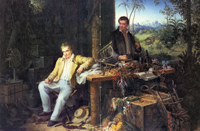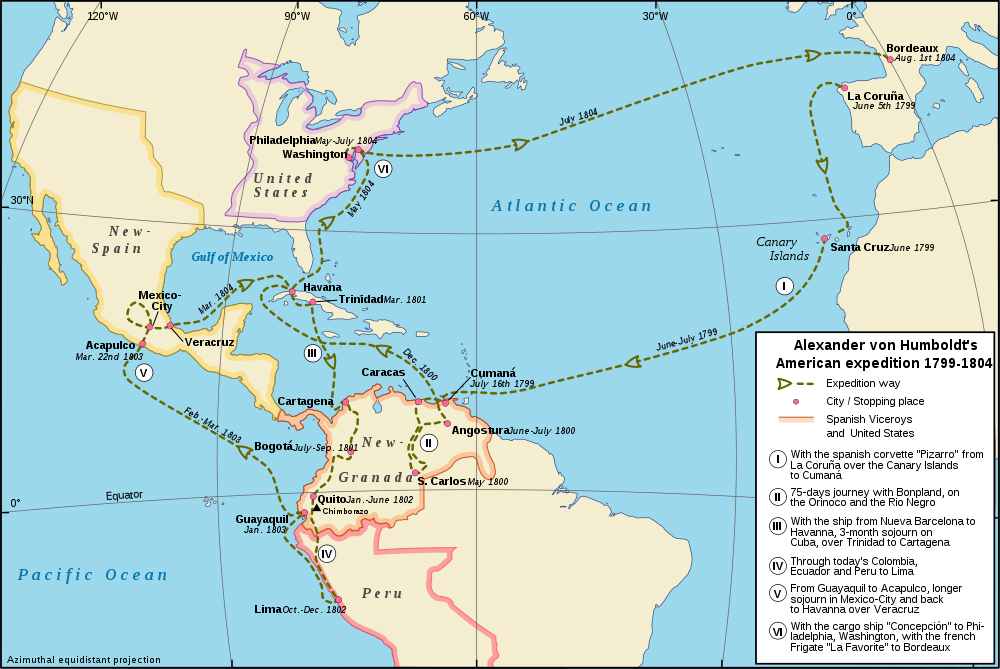Meeting 7 • 28 January 2014
|
Version: |
|
pictures of the week |
|
|
|
mini-text of the week (start): "The destruction of the forests… forcefully explains why the present Lake Valencia is decreasing.…"Humboldt, "Personal Narrative", from Jaguars and Electric Eels, ed. & trans. Wilson, p. 31 (read more) |
|
(10')√ Thought-bites of last week and this week (and picture of the week): Humboldt and his barometer and his rocks. My current reading (some of it): history of barometer, history of geology, history of Inquisition. Barometer was at first an experiment to prove/disprove existence of vacuum ("Nature abhors a vacuum"; "horror vacui"; "natura non fecit salta" [Latin is approximate]). Wide range of explanations of geological formations. What were "facts" / "reliable observation"? How many facts / what proportion of all theoretically available facts were needed? What about competing scientific explanations (not just the larger disagreements related to belief / proof systems like science, formal religion, folk beliefs)? Problem with the image of the Great Scientists who single-handedly comes up with THE Explanation that, in one giant step, destroys the uninformed delusions of heretofore (and who are never wrong about anything else, in science or elsewhere): We acquire a distorted notion of the history of science as constant progress toward certainty "Nature and Nature's law lay hid in night. God said, 'Let Newton be, and all was Light'". (Pope - Alexander Pope, not THE Pope) "We are but dwarves standing on the shoulders of giants." (Newton, a practicing astrologer and Christian - and also not a very nice person) Hypotheses and confusion about data and "theories". Bumper sticker: "Sure, evolution is just a theory - like gravity." Preview: science / religion ("and", "vs."?) |
|
(5')√ Mini-text of the week: a core document of thinking / research about human-caused climate change. This week's theme: plants, and also food. |
|
(20')√ SINQing the Humboldt canoe, so that we can then load it and travel safely in it. 1) "Semi-Brute Force Solution: "dry dock" simulation using Laura Dassow Well's description of Humboldt's canoe and its cargo of people, equipment, and various critters- we'll do that right in the classroom; 2) "Smart Person Solution": saving time and sweat by (e-)pencil-and-paper calculation of volume and "ball park" estimation of weight and displacement. Preview today, with cylinder as basis (some group using English, some groups using metric units). Our materials: Humboldt "canoes" made from quart carton (heavy cream) and orange juice can; "rivers" to float our canoes in (pitcher, yogurt container; water; rolls of pennies; brains and calculators (human or machine). Thought questions for preparation: What is the volume of that original Humboldt Canoe (40' long, 3' wide, semi-circular cross section throughout)? How about one with a 3' width, rectangular transom (1.5' high), and flat bottom? How about one with a triangular cross section (3' wide, with bottom (keel) as right-angle? How does that relate to how many supply and sample boxes they could get into the Canoe, how much wood is needed to make various shapes of containers, and what your airline carry-on baggage allowance is? Would(n't) this all be easier if we used the metric system? ••Maybe: Worksheet about volume, weight, and displacement. What does all this have to do with: "displacement"; getting up the Orinoco, through the Casiquiare Canal, and down the Amazon (see map above); the Whiskey Rebellion; the Mexican War; and the science and economy of then and ("interpreting the past") now? |
|
(15')√ About educational standards (PSU and elsewhere) and their parts in the course: 1) evaluating own education; 2) helping others to learn - how standards are used to develop curriculum (curricula?) and learning activities Writing assignment 3: Your education and how it compares to standards. Due 4 February (Tuesday) deadline changed to 6 February, Thursday. A look at some of those standards (as we did last week with Weitsch portrait and Fine Arts standards). About "standardized tests". |
|
(05')N About Humboldt-named schools and their role in this course; featured schools: PDX (now closed - summer of 2012), Arizona, CA (Humboldt BAY HS), Illinois (AvH Chicago), NYC, Saskatchewan, Mexico City, Puebla, Berlin-Tegel, Hamburg, Rüsselsheim, Kazakhstan; reinterpreting the past better for ourselves by (re)interpreting it for others. Upcoming: choosing your Humboldt-named school as source of info about education and possible beneficiary of your project(s). |
|
(05')N The Weitsch portait of AvH - relation to long tradition of portrait painting (and photography, including the pics you take of yourselves to express your identity/ies); the emergence of the scholar/ scientists as claimed co-equal of the ruler, churchman, soldier. |
|
(05')N about writing skills and critical thinking: ways to structure "Leaving Home" (abstract>specific, specific>abstract, only specific and let reader figure out the point, gnomic utterance / specific / abstract [or just end with specfic and let reader figure it out]); work sample (see handout from meeting #3); importance of a concept of change (in our individual lives, in development of human thought - was that concept always around? -, in study of origins of sustainable environmentalism). Some words/ phrases that can undermine your writing: literally, virtually, multiple, pertaining, prior to, I think, in my opinion, and '-ing" (Prior to leaving my home> Before I left home OR I did x. Then I left home. OR I left home Before I left, I …). |
|
(05')N Reminder about reading assignments. 1) Does everyone have the main texts and know where to find assignments and deadlines? Has everyone read the Wikipedia article about AvH? Gotten well into Helferich and Eels/Jaguars? 2) Has everyone done the several questionnaires? (Intake experiences • Skills inventory I • Academic background & interests). Preview of book review assignment: 1) purpose and chief features; 2) choice of books (with some additions to come, to cover more topics or allow for books from PSU/MultCo libraries or your own resources) |
|
(05')N if time: some more apps |
|
(0') Start reading these on your own time: Previews & announcements:1) Note how I have annotated the outlines for previous meetings with comments (key to symbols) about what happened during them; 2) Portraits of ourselves as environmentalist-explorers. 3) Upcoming: choosing areas of specialization for individual reading, lesson-plan project, team project. 4) Keeping up with the reading – see "schedule" page; maps now available; pagination of printed vs. e-books. 5) a leftover from the Hawaiian trip - while you're thinking about such things as chocolate, macadamis nuts, and coffee, look at Jaguars and Electric Eels (p. 21) and these links (link 1 • link 2) to see how modern AvH was in his beverages, and read Jaguars p. 44 about his fashionable food interests. 6) Soon we'll load and crew a mockup Humboldt Canoe - still thinking about SINQing a real canoe (depending on local warming/ cooling). Use your computer/ smartphone map links and applications to trace AvH's route in South America, starting with his travel up the Orinoco and down the Amazon. See Helferich, p. 52 map, but be aware that |

